#Integrated Power Module
Explore tagged Tumblr posts
Text
Dimmable LED driver replacement, triac dimmer, Integrated Power Module
347 - 480Vac, 100W, 100 - 1100mA, 48-143V, [0-10V], IP66 LED Driver
0 notes
Text
What Is A Programmable Power Supply?

A Programmable Power Supply is a digitally controlled device that allows users to set and dynamically adjust output voltage, current, and frequency in real time. Unlike traditional power supplies that provide fixed voltage or current, a PPS enables flexible adjustments to meet specific testing requirements.
Get more details: What Is A Programmable Power Supply?
#electronics#integrated circuits#semiconductor#components#electronic#module#electronic devices#chips#manufacturing#power supply
0 notes
Text
youtube
Power Integrations: SCALE-iFlex Module Gate Drivers with Temperature Readout
https://www.futureelectronics.com/m/power-integrations . Power Integrations' SCALE-iFlex LT NTC family of IGBT/SiC module gate drivers provide Negative Temperature Coefficient (NTC) data, which enables accurate thermal management of converter systems and ensures proper current sharing. They dramatically enhance the overall system reliability of renewable energy and rail systems with multiple modules arrayed in parallel. https://youtu.be/HDg0zpG5wus
#Power Integrations#SCALE-iFlex Module#Gate Drivers#Temperature Readout#NTC Data#IGBT#SiC Modules#Thermal Management#Converter Systems#Renewable Energy#Rail Systems#System Reliability#Module Gate Drivers#Youtube
0 notes
Text
https://www.futureelectronics.com/p/semiconductors--real-time-clocks/stwd100nywy3f-stmicroelectronics-2002188
Real time clock power loss, automotive timing device, Real-time computing
STWD100 Series 5.5 V 13 uA Surface Mount Watchdog Timer Circuit - SOT-23-5
#Real Time Clocks#STWD100NYWY3F#STMicroelectronics#real time clock power loss#automotive timing device#Real-time computing#integrated circuit#Real Module#real time clock microcontroller#Digital Clock#watch crystal#ip-clocks
1 note
·
View note
Text

My concepts for the development progress of an Iterators Puppet
-my ideas below
-Feasibility Study
[1]: First autonomous control module, any instruction to be given must be done manually through physical means (the keys), outputs were shown through the screen. A very primitive system, however, did its job proving the greater machine concept was achievable. While it does look like a lens above the monitor, this was a simple status gauge for benchmarking.
-Prototyping and Development
[2]: Now with the capability to wirelessly and audibly communicate to receive instructions and inputs. The system was no longer directly integrated into the facility, and resided on the first instance of an iterator's arm. This was considered a feat due to the complications with isolating the control module from the rest of the iterators components, while keeping processing power. A permanent connection/umbilical was needed to sustain life and function though.
To “talk” back, they were crafted with multidimensional projectors, the mobile arm allowing the angles and variance for this projection. Only later into development were advanced speakers installed for optimized understanding, however the extra computing power required to synthesize proper speech was found to strain the contained module, so this function had rare use in the end.
[3]: At this point there was a change in perspective in the project. What once were machines to simply compute and simulate, were now planned to be the home, caregiver, and providers. The further the project came to fruition the more religious importance was placed upon these “random gods”. From this stance not only did the puppets have to manage and control their facilities, they had to communicate with the people and priests. To represent benevolent beings who will bring their end and salvation. In this process iterators began to take a more humanoid shape, to better reflect their parents. Development was focused on compacting the puppet closer to the size of an ancient for this purpose. This stage was the first to incorporate a cloak/clothing into their design considerations, to further akin themselves in looks. The cloak would hide the iterators' engineered bodies and give a body to their silhouette.
[4]: As bioengineering and mechanics were rapidly progressing due to the void fluid revolution, this allowed plenty of margin for developing the outer design of the iterator puppets. This prototype was the first to incorporate limbs for the purpose of body language. This was another step in the drive to give a body to their random gods.
-Final Iterations
[5]: First generation iterators had the final redesign of puppet bodies. Far different from their first designs, they are fully humanoid. Their bodies are shaped to be organic and as full of life as they could at the time. Their center of sapience has fully settled within their body, as can be seen as their unconscious use of limbs without the direct intention for communication. This can also see how they manage their work, where many of the functions (which can be done with just an internal request) are operated through physical gestures of their limbs. Their puppet chambers also allow for full comprehensive projection, where many of their working monitors are displayed. It is seen how iterators prefer to utilize their traversal arm to transfer between the current working projection window.
These designs were hardy and nearly self-sufficient, only requiring minimal power from their umbilical to charge. (However was still limited in the terms of internal power production, for this first generation extensive batteries sufficed)
[6]: Later generation not only incorporated advanced bioengineering internally, but externally. While still a hardened shell, their body plates have been incorporated into the organics of the puppet, maintaining the protective requirements while barely leaving a trace of hinges or plates. This “soft” skin had drawbacks, such as reduced durability to the first generations, this was offset by the greatly enhanced repair speeds and capability this type of skin allowed.
Internal power generation was implemented into these late generation models. If the case arose, the Puppet could be disconnected from their umbilical and still be conscious from an undefined period of time. (However this would limit the operating capacity of the puppet when running self sufficiently) This greatly eased maintenance works, as the Puppet could still run the greater facility wirelessly while work was done on the chamber, arm or whatever as needed.
2K notes
·
View notes
Text
How the Arknights Community was Wrong on One of Arknight's Most Powerful Classes
Or, alternatively, you all need to apologize to Rosmontis right now.
Flingers are experiencing a modern Renaissance right now. Thanks to the release of Wis'adel and the introduction of Rosmontis's absolutely busted IS module, it seems like things are on the up and up for Flingers. Even Greyy the Lightningbearer is a common sight in high level IS runs, and he doesn't even have a broken module.
How on Earth did this happen, when it wasn't very long ago that Flingers were the butt and punchline of their own joke?
The Original Let's start with how the archetype was introduced into the game: Rosmontis. Rosmontis was released alongside Mudrock for the Chapter 8 release event, and the reception was pretty mixed. Rosmontis was a limited operator, and to this point, limited operators in Arknights had been pretty middling. Nian wasn't really conclusively better than Hoshiguma, and W was good but nothing special. We were not at the point yet where Dusk or Skadi the Corrupting Heart had been released, so the running joke was typically to roll on the other operator on a limited banner. Mudrock was a really strong laneholder that still sees a lot of use today, and Weedy is by far the strongest shifter operator ever released.
It's also worth noting that Rosmontis was released during a general downturn of opinions on AoE ranged operators. Leonhardt and Meteorite were considered actually quite strong in the early days of Arknights, and I know this must sound crazy, but Mostima and W were actually super hyped for their release. People thought Mostima, base-ass Mostima with no modules, was good. But after CC Blade, and a general stint of CCs where AoE operators made relatively poor performances, the tide had shifted. Operators like Eyjafjalla and Angelina (god remember when Angelina was considered really good. Well I guess she is now. Regardless) had AoE capabilities but were much cheaper in DP and had solid secondary skills for dealing with single enemies. So people were generally pretty down on AoE operators, which wasn't helped later on by the release of Passenger, an operator considered so bad it resulted in several attempts by Hypergryph to make him better (the retrospective view is that while Passenger was bad, he was made out to be a lot worse than he was, a view I agree with).
These two factors did not help the views of Rosmontis as an operator, but it was also further not helped by what content was available to use Rosmontis in: Contingency Contract. Rosmontis, tragically, released after the first theme of Integrated Strategies came and went, and so the only high level content available to use her in was CC. CC is particularly harsh to Flingers as we'll discuss, but this is also something that Wis'adel has managed to avoid as there hasn't been a CC since her release. The only difficult content since Wis'adel's release has been IS and RA, two game modes that honestly favor Flingers as we'll discuss later on. There was just nowhere to use Rosmontis in more difficult content where she didn't feel bad.
Flingers are a pretty interesting subclass, and Arknights has really not designed any subclasses to be like them, ultimately. They have a very impressive attack range, higher bulk than other ranged operators, and a unique gimmick to their attacks: they will deal an additional hit of damage, but one that only has 50% of their ATK. In addition to this, Flingers are the only Sniper subclass that cannot hit aerial enemies without certain conditions being met (Wis'adel's S3, Rosmontis S3 with an aerial blocker).
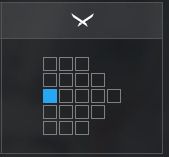
In general, this results in a class that is very good at dealing with large groups of enemies with only modest DEF stats. This is because DEF ends up having an increased effect on Rosmontis' damage, because it will apply to both of her hits. An enemy with 375 DEF will, after the 175 Def ignore from her talent, reduce her attack damage by a total of 400.
This for a lot of people was sort of the final straw that broke the Rosmontis back. Her vulnerability to enemies having DEF was a problem, and it was generally stated to be in a way that other DPS checks would avoid. In addition, if we take a look at ideal DPS scenarios with the introductory 6-star for each Sniper class:
Ray: 1,346.22 Narantuya: 1,062 Schwarz: 880.28 Exusiai: 815.99 Chen the Holungday: 647.17 Rosmontis: 601.71 Fartooth: 583.88 Rosa: 539 W: 373.93
Rosmontis is very middle of the pack, losing in particular to Exusiai. Now, Exusiai also had the problem of being very soft to enemy DEF stats. Honestly, it should be noted that Rosmontis was always hitting higher DPH than Exusiai would for her normal attack damage.
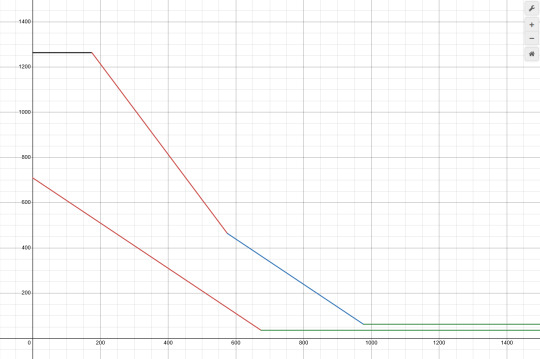
(I've been getting really into Desmos lately)
Now this is all just auto-attack stuff and I don't want this to be exclusively a Rosmontis analysis by any means (although it's coming). The point here is that there was a pretty common conception that Rosmontis didn't really have a place in the meta, because Exusiai was so dominant in that spot. It's not hard to understand why. If we look at their S3 DPS really quickly...

At low DEF values, Exusiai is overdominant. This isn't super surprising, as she has a lot of factors working in her favor: a busted 5 hit S3, an attack interval reduction as well as a sizable ASPD buff from her talent. But it doesn't take a huge amount of defense for Rosmontis to come out on top. The specific DEF number is 580, roughly. Then, the perks of Rosmontis's S3 come to light: it's larger DEF ignore, it's halved attack interval, and it's much larger ATK buff.
This being said, there are still things working against Rosmontis, like her skill cycle being very long, and her own ATK buff resulting in Warfarin's buff being diluted compared to Exusiai. If you take a look at CC results, it is true that Rosmontis only has one top to her name: CC Spectrum, where she is part of a Risk 31 clear alongside Exusiai, which is pretty cool. But CCs, which often increase enemy DEF while reducing friendly ATK, are just very harsh to Flingers. Given that it is a class so sensitive to DEF and ATK changes to hit breakpoints, most CCs just hit Rosmontis in a double bind.
Funnily enough, Exusiai also doesn't have any top clears in CC past this point too, which is interesting to point out.
(For those counting: Rosmontis: CC5 Exusiai: CC1, CC5)
Rosmontis' position probably wasn't helped past this point by the release of Chen the Holungday either, and the rest is history. Rosmontis goes down as one of the weaker 6-stars in the game. People feel bad when they roll her. People on this website nurse weird ass grudges against her.
The Blip
It would be remiss of me to not remind people about Greyy the Lightningbearer. Greyy was a 5-star, which means that 99% of players ignored his existence, Gamepress made a dogshit summary about him that was made by people who don't play the game, and life moved on. We're going to talk about Greyy in more detail later on because he is important to talk about...
Oh well right now
Lone Trail: The Update That Should Have Changed Everything
Lone Trail was a super massive event, releasing three 6-stars that can be kindly regarded as "good but nothing amazing, bad, and my wife". It also introduced to the game the Flinger Modules, and I'm going to tell you all a secret. You and me, real close now.
It's fucked up these modules didn't receive more hype.
These modules gave Flingers a second shockwave hit. Now that doesn't seem all that impressive. After all, you might think to yourself, that shockwave still deals 50% damage. But the addition of an extra shockwave really changed the numbers of the game, because it meant a huge chunk more damage.
At minimum (673 DEF roughly) this module improves her damage by about 45%. That's pretty crazy for a module as it stands, but if you want to see the full chart, here you go. Arknights Youtubers hire me.

The extremely high peak there, where Rosmontis is doing more than triple the damage she was originally is actually getting to the exact point where Rosmontis without a module moves towards dealing scratch damage. This is pretty common with modules involving physical DPS operators, such as Blaze, to have very unique high points.
But this is 45% just off of, what is essentially
An extra shockwave
60 more points of DEF Ignore
+75 ATK attribute
This is a remarkably tame talent upgrade. The base effect, the second shockwave, is pulling so much work here. These numbers will be a bit more tame when you compare with S2 (already comes with +2 shockwaves) or S3 (already has some DEF shred) but this is still a very impactful module.
It also impacts the stun chance on her S2. Without her module, and having 4 total hits per attack, this puts her stun chance at roughly 59.04% per attack. The additional hit raises those chances to 67.232%. Not a massive increase, but it does help to patch up her odds.
This is also why Greyy's module was so important. Greyy's slow is tied to his talent, and hence the jump from 2 hits to 3 hits is very notable. Without his module, Greyy has a 64% chance to slow the enemy with every attack. With his module, those chances go up to 78.4%! That's pretty significant! He also deals 15% more damage to Slowed enemies too, which is a pretty strong mod on top of the extra shockwave. I haven't actually done Greyy's numbers, but it really does make him a lot more consistent at slowing enemies.
So now we're here, with Flinger's getting a surprisingly good module. They now deal 3 hits per attack, with Rosmontis dealing 5 hits per attack with her S2, which is actually relevant for Lone Trail (Rosmontis can remove a clean 250 DEF with every one of her attacks during her S2 against Arc Screenguards). So what happened?
Well...Flingers weren't popular, were widely regarded as a flawed class, and mostly passed over. It just wasn't worth it to people to raise Rosmontis or Greyy the Lightningbringer even if you had some inkling their module was good.
The Return of Integrated Strategies and Reclamation Algorithm
A miracle the likes of which Hypergryph may never do again...well okay maybe they will, they do be kind of nailing it on the alternate gamemodes, we have the return of Integrated Strategies and Reclamation Algorithm. These modes are actually uniquely situated in comparison to CC to benefit Flingers over other classes. This is largely because of how these modes chose to scale difficulty and the tools they give you to combat this.
In IS, enemy difficulty typically results in scaling HP and ATK buffs, and that's it. It's rare to see enemy DEF buffs in IS. In addition, many relics in IS focus on increasing ATK or ASPD or improving damage dealt. Flingers get much and much better when they deal damage with their shockwaves, and it is pretty easy to do that in IS. Rosmontis's S2 is of special note here: with her module, it deals 5 hits of damage, which means it benefits from ATK buffs to the same degree as Exusiai does, but with a lot of added perks. DEF ignore, a moderate AoE radius, and a chance to stun. This skill is way more dangerous with additional ASPD.
Greyy also benefits a ton here. Extra ASPD allows him to basically permanently lock down entire groups of enemies with slow. This is something that can also sort of be done with Chain Casters, but notably, Chain Casters can only slow down a certain number of enemies at a time with each of their attacks. Since slowed enemies tend to create clusters, Greyy can slow down entire waves of enemies with his attacks, while still dealing pretty impressive damage.
The only issue is the aerial enemies. I haven't mentioned this up until now, because in my opinion, it is the single most overhyped drawback in the entire game. There are tons of events and chapter releases where this basically doesn't matter. Aerial enemies are, for all intents and purposes, rather rare in Arknights. But in IS this is important. Flingers need some degree of map knowledge to use well. But your Sniper ticket is not necessarily the only solution to aerial enemies in any IS, and chances are you'll find more than one. For IS3, you can pick up Kroos Alter and Rosmontis and in the grand majority of situations be completely fine.
Of course, if you play IS5, this basically isn't an issue and Rosmontis is the second stronger Flinger in the game, and I think arguably the second strongest Sniper pick?
I almost forgot RA by the time I went to post this, so it's a good thing I went back because, yes, Flingers and Rosmontis are also good there too. It's literally designed for Flingers to be good, it's huge mobs of enemies all clustered closely around each other. You can use Provisions to give Rosmontis a ton of ATK or ASPD and watch her go ham on like 115 exploding spiders. They also have amazing range for vision on resource maps and have multi-hit mechanics for those stupid locks.
It's like, impressive how nicely Flingers slot in here. I'm really curious how Greyy feels when you give him one of the ASPD provisions so he has +60 ASPD.
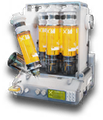
Rosmontis CRAVES your Coagulate Supplements!!!!
The End-Times: Wis'adel and Rosmontis's Busted Module
If you've ever wanted to know how we got to this renaissance, it was Wis'adel being released, having absolutely busted numbers on her kit that basically ensured that her shockwaves would always do damage, and then going and soloing IS3 A15 like it was fucking nothing.
Wis'adel proved Flingers could be fucking fantastic.
Rosmontis has actual problems in her kit, she's ultimately a pretty early Limited operator with all the design choices that carries. Wis'adel is what you get when you ask "how far can a Flinger go?" The shockwave mechanic works well with her huge numbers and her shadow status effect. Her summons work to keep as many enemies as possible attached with a shadow. Her blast radius is massive. Honestly the fact she can blow up the UFOs in IS3 barely matters.
Soon after that, Rosmontis got her specialized Module. I've seen people complain about this. You're wrong. There's no fucking way this module should be allowed to be used in general content. It is, in fact, maybe the most busted specialized module they've released. It completely changes Rosmontis as an operator. Benefitting from Caster relics is insane for themes like IS3 which has a ton of genuinely broken ones, her new and improved equipment are insanely powerful, and the fact that she allows every Sniper and Caster to create a free rather tanky blocker with a crazy debuff effect is like
You understand this module is nuts? Surely?
The trait wouldn't really make Rosmontis meta anyhow. It would improve her damage by a lot but puts her, rather frustratingly, into the camp of mixed offensive operators who now have to worry about enemy RES values coming into play. Plenty of the enemies with decent DEF stats that Rosmontis struggles with now also come with sizable RES stats. As I've mentioned in my brief thoughts on Dagda, there are a ton of enemies Dagda hits harder by brute force than Indra does by trying to side-step the bigger stat.
It's also okay that the module is IS only, because IS is where Flingers are just at their best. Nothing is stopping you from using Rosmontis in general content, especially with her still really good BOM-X module!
Flingers, ultimately, are just a well-designed class. They have great range, AoE, and having extra instances of damage is always incredibly powerful. I do think Rosmontis has some kit issues, but I also think that a lot of people immediately dismissed her as bad based on community consensus. You want to know a cool thing about Rosmontis I haven't brought up yet? She can attack invisible enemies with her S3. Invisible enemies feel a lot more common than aerial enemies do, hell Lappland the Decadenza's event is literally a bunch of invisible enemies.
But like, that's never seen as a positive to Rosmontis unless you're a Sniperknights player and then you might just say Totter is better (and I get that, he is a bit more consistent). Rosmontis can hit an entire enemy type with her S3 that Wis'adel can't, but it's seemingly never mentioned. It's just...this community is very strange, you know?
Try Rosmontis out, hell try her out with Shamare or Warfarin. If you use Exusiai a bunch (godspeed soldier it's been rough since the Chen days), you probably already have those operators. Try Greyy out too. Then, if you really want the challenge, E0 Level 1 Wis'adel. Come on. You know that's better than like half the cas-
167 notes
·
View notes
Text
Arknights Thank You Celebration 2024 PVs
youtube
youtube
New Operators

Figurino, 5* Merchant Specialist
I have a lot to learn, and right now, i'd like to start by making a new suit.
Crownslayer, 6* Welfare Executor Specialist
"Crownslayer", that's the name we're familiar with, let's keep it.
Vulpisfoglia, 6* Pioneer Vanguard
I appreciate the acknowledgement. But you know this means in the future the people who are hunting me for bounty will come to Rhodes Island first. Will that be fine?
Lappland the Decadenza, 6* Limited Mech-Accord Caster
Is this your way of trying to get me to settle down, or do you also think this game needs more excitement...
I just can't guess you, no wonder i like your trust in me!
2 new operators to the voucher shop
Contrail, 4* 巡空者 (Air Patrol) Specialist
Philae, 5* 本源铁卫 (Primal Protector) Defender
Operator Outfits Update







Total of 6 new outfits, 2 new additions for the Cambrian brand, 1 new addition for the Epoque brand, 2 new additions for the Test Collection brand and 1 new addition for the 0011/Tempest brand
Cambrian
At the Warm Velvet Corner - Warmy
Travel Freely - Sussurro (Login Event)
Epoque
Il Segreto Della Notte - Texas the Omertosa (21 OP)
Test Collection
Allmind As One - Executor the Ex Foedere (24 OP)
The city lights up. I can sense everyone's presence, and everyone's absence. We are together——— as one "Laterano".
Diversity Oneness - Virtuosa (24 OP)
Please stay, Sankta. Please tell me, is the Laterano of now a place that is connected to the rest of the land?
0011/Tempest
Ignis Fatuus - Lessing
Lessing's outfit will be up for sale during Zwillingstürme im Herbst Retrospect

Announced outfit reruns
Young Branch - Muelsyse
Red Countess - Skadi the Corrupting Heart
Operator Modules Update



All the new operators (except the red cert shop ops) being part of branches with modules immediately get their modules
FUN-X module base effect increases the starting damage of Lappland the Decadenza's drones to 35% of her ATK
SOL-X module base effect gives Vulpisfoglia +8% ATK and DEF when blocking
EXE-X module base effect makes it so retreating Crownslayer refunds 80% of her current DP Cost
MER-X module base effect reduces the DP drained by Figurino's trait effect
Ritualist Supporter branch gets 1 module type
Lessing gets his second module
DRE-Y module base effect allows Lessing to survive a single fatal blow, healing back to full and gaining +30 ASPD at the cost of -60% Max HP, this effect only activates once per deployment
Angelina and Rosmontis get Integrated Strategies specialized modules
These modules' effects are unknown at the time of writing
Events and Stories

I Portatori Dei Velluti, a Siracusa side story event
Put on your masks and dresses, the show is about to begin in the streets.
Come on, don't be boring - you're probably the least "Carnival" of the bunch!

Stronghold Protocol, limited time autobattler gamemode, opens during the third week of I Portatori Dei Velluti
Zwillingstürme im Herbst Retrospect, scheduled after I Portatori Dei Velluti


Operator Archives update for Lessing, Jieyun, Schwarz, Sora, Totter and Vigil
Misc Stuff


New QoL changes
Added the ability to have preset base loadouts that you can easily swap between
Added the ability to instantly send every exhausted operator into dormitories with one button
Max Sanity cap increased by +45
Refilling sanity using Originite Prime will refill 135 sanity regardless of level/max cap
Added the ability to instantly move to required lower materials when crafting and a button to move back the higher tier material that required it


Mountain, Kafka and Pinecone added to recruitment
Bagpipe's [Queen, No.1] outfit will be available in the certs shop to players that don't have it
Livestream Stuff
Showcased Lappland the Decadenza, a hyper offensive 6* Mech-Accord Caster with potent self buffs and powerful debuffs
First talent makes her stronger the longer she stays on the field, getting the following buffs in order: increased drone damage cap, ability to inflict Silence, gains more drones
Second talent increases the initial SP of all [Siracusa] operators when she's in the squad
Skill 1 has a passive effect that immediately gives her an additional drone, when the skill activates she gains ATK, releases her drones to attack enemies and her drones will attack idling enemies anywhere on the field
Skill 2 expands her attack range, increases her ATK, gives her more drones and releases her drones to attack enemies randomly within range, her drones have a chance to inflict Panic
Skill 3 increases her ATK and gives her more drones, then releases special drones that actively seek out and hunt enemies, the special drones inflict Panic upon reaching a target and locks onto them; enemies near the drones will have decreased movement speed and take Arts damage every second
Showcased Vulpisfoglia, a 6* Pioneer Vanguard with a strong battlefield presence
First talent makes her attacks deal additional Arts damage for a few seconds after the first time hitting them
Second talent increases the natural DP regeneration by a small amount and lets her recover HP when she hasn't taken damage for a few seconds
Skill 1 is a power strike skill that makes her next attack deal Arts damage and generate some DP, this skill can store charges
Skill 2 lets her immediately deal Arts damage in an area in front of her, Slows the hit enemies and generates some DP. If the enemies were already under the effects of Slow they will be Stunned instead, this skill can store charges
Skill 3 immediately generates DP, expands her attack range, increases her ATK, gives a massive decaying ASPD boost, allows her to attack enemies equal to block count and each attack briefly Stuns the hit enemies. If she defeats any enemy during the skill she will gain Camouflage at the end of the skill that lasts until the next skill activation
Showcased Crownslayer, a 6* Executor Specialist with a unique disruptive kit
First talent sprays a smokescreen on the 8 surrounding tiles around her during skill duration, reducing the Physical and Arts Hit Rate of ground enemies in those tiles
Second talent lets her deal increased Physical damage to enemies that have not landed a hit on her
Skill 1 gives her increased ATK and some amount of Physical and Arts Dodge
Skill 2 stops her from attacking upon deployment, makes her less likely to be attacked and increases the amount of Physical and Arts Hit Rate the smokescreen decreases, when skill ends she will deal a certain % of ATK as Physical damage to all enemies within range
Skill 3 increases her first talent range, gives her Invisibility and sets her Block Count to 0, every few seconds she will appear to attack an enemy within the talent range dealing a certain % of ATK as Physical damage and Stunning them for a few seconds


Showcased the event mechanic, a fireworks machine that will apply effects on a number of tiles around it when activated
While the machine is active, operators on those tiles will take periodic damage and cannot be healed but will not have their HP go below 1, enemies on those tiles will take constant damage
Players can additionally customize which tiles will be affected by the fireworks machine and have it apply additional bonus effects in the event menu
Showcased Contrail, an experimental 4* of a neat new branch 巡空者 (Air Patrol), a Specialist branch that consists of operators that have 2 Block Count and utilizes the new status "Takeoff"
Takeoff: Does not block ground enemies and will not be attacked by ground enemies, can block aerial enemies
S1 makes her takeoff immediately upon deployment, expands her attack range, increases her ATK and gives her some Physical Dodge
S2 makes her takeoff when activated, expands her attack range, increases her ATK, lets her attack 2 targets at once and is able to attack an additional aerial enemy and her attacks inflict Slow to aerial enemies
Showed footage of the new base loadouts feature
Work rooms and Dormitories are now in separate tabs
You can set up to 3 loadouts for each individual room and press a button to immediately swap out exhausted operators, there is also a button to immediately do this in every room all at once
Showed the button that immediately sends all exhausted operators into the dorms

Teased even more base QoL features planned for the next Sui sibling event update
Expanded the Reception Room and added the ability to decorate it
Added activity rooms, operators assigned to this room can be manually controlled and move around the base

Announced the ability to register your birthday, players will receive gift furniture on their set birthday and operators have special birthday voicelines

Announced the ability to have a list of rotating assistant operators that change every day
Announced the ability to make loadouts for the main menu background/UI theme/assistant operators for quick switching
SSS will get a skip feature, uses the same PRTS Proxy Cards used for annihilation skip
The older SSS maps will become playable again


Stronghold Protocol, limited time autobattler gamemode
In the gamemode the player will have to prepare their squad and operators before each battle, the player can hire additional operators and have multiple copies of them deployed or combined into a higher tier of that operator
Players can hire reserve operators should they lack usable units and also hire up to 8 friend support operators


Teased the next event involving Thorns and the history of alchemy in Iberia
Announced some kind of mini game collection "Poly Vision Museum"

Announced the second expansion update for IS#5
A 5th ending exploring the story of an alternate universe Amiya
The ability to share seeds of runs you completed to other players, completing a seeded run will not unlock higher difficulty/new relics/etc
Max difficulty increased beyond 15
New starting squads
New collectibles and thoughts (IS5 gimmick items)
Teased Arknights anime season 3 [RISE FROM EMBER]
Announced U-Official mini series
Announced Ambience Synesthesia 2025: Best Song Award, the song lineup featured in the concert will be decided via community polling
INVESTIGATED TERRA lore video covering the history and development of Originium on Terra and the technology that sprouted from it narrated by Kal'tsit
85 notes
·
View notes
Text
What Is A UPS?

An Uninterruptible Power Supply (UPS) is a device that provides continuous power supply, especially in the event of abnormal power supply or outages. The UPS contains built-in batteries or other energy storage devices that can supply stable power to load devices for a short period, preventing damage or data loss caused by power failures.
Get more details: What Is A UPS?
#electronics#integrated circuits#semiconductor#components#electronic#module#electronic devices#chips#manufacturing#power supply
0 notes
Text
youtube
Power Integrations: SCALE EV Gate Driver Boards
https://www.futureelectronics.com/m/power-integrations . Power of Integration. Our SCALE EV gate driver boards for automotive-grade Econo-Dual modules reduce component count by 50% with the only active components being two safety-isolated, automotive-qualified PI ICs. https://youtu.be/_K5Rk_Oe_7Y
#Power Integrations#SCALE EV Gate Driver Boards#Automotive Grade#Econo-Dual Modules#Gate Drivers#PI ICs#Automotive#Electronics#Safety-Isolated ICs#EV Technology#Electric Vehicles#Innovation#Gate Driver Technology#Youtube
0 notes
Text

1958 Chevrolet Corvette
This 1958 Chevrolet Corvette underwent a pro-street-style metamorphosis between 2008 and 2011. It is endowed with a 383 cubic inch stroker V8 engine, harmonized with a TH350 three-speed automatic transmission, and a narrowed rear axle featuring a limited-slip differential. The rear suspension has been upgraded with a ladder-bar configuration, adjustable coilovers, and the addition of a lift-off hood. The body, painted a striking red with white coves, comes with a detachable hardtop. Inside, a roll cage has been installed along with a B&M Pro Stick shifter, a shift light, aftermarket gauges, and black Procar bucket seats. The enhancements also include dual Edelbrock carburetors, Hooker headers, side-exit exhaust pipes, 15” alloy wheels, and front disc brakes. Acquired by the current dealer in February 2024, this modified C1 Corvette is now part of the Coffee Walk Corvette Collection in Wylie, Texas, and is offered without reserve, complete with build records and a clean Pennsylvania title.
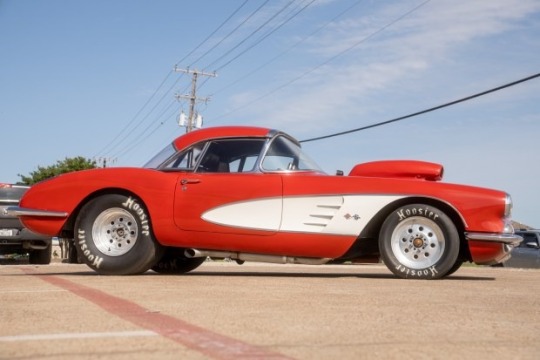
1958 Chevrolet Corvette
The fiberglass exterior is adorned in red with white coves and includes a removable hardtop and a lift-off hood with an integrated air scoop. A Stewart-Warner fuel-pressure gauge is mounted on the cowl, and the right-rear corner features a battery cutoff switch and external terminals. The gallery reveals cracks in the weatherstripping, pitted chrome, and paint imperfections.
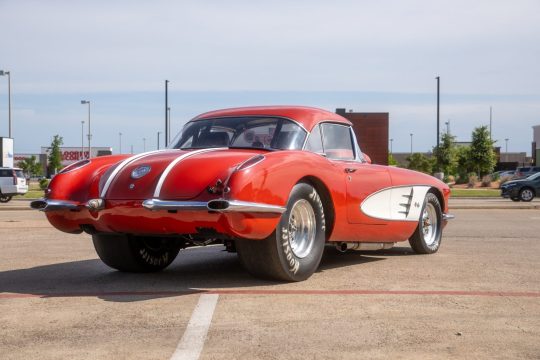
1958 Chevrolet Corvette
Polished 15” alloy wheels are shod with 25.0×5.0” front and 29.5×11.5” rear Hoosier drag tires, installed in April 2024. A crossmember supports the rear suspension, which has been modified with ladder bars, a diagonal link, and adjustable coilovers. The braking system includes front disc brakes and rear drums.

1958 Chevrolet Corvette
The interior is equipped with a roll cage and Procar high-back bucket seats in black. Enhancements include a B&M Pro Stick shifter, an MSD shift light, rocker-switch controls, and fabricated metal door panels. The gallery displays flaking paint and wear on interior surfaces.
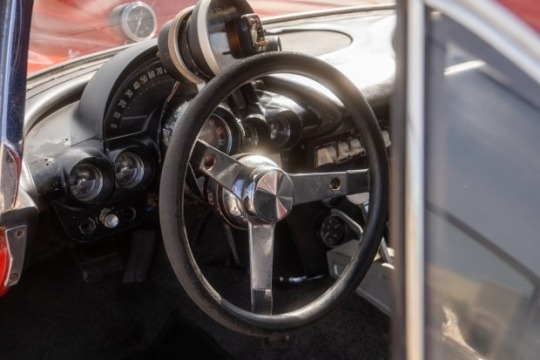
1958 Chevrolet Corvette
The three-spoke steering wheel is positioned in front of a 160-mph speedometer and auxiliary gauges. An AutoMeter pedestal tachometer is mounted atop the non-functional factory tachometer. Additional gauges for coolant temperature and oil pressure are located in the center console. The mechanical odometer is inoperative, and the total mileage remains unknown.
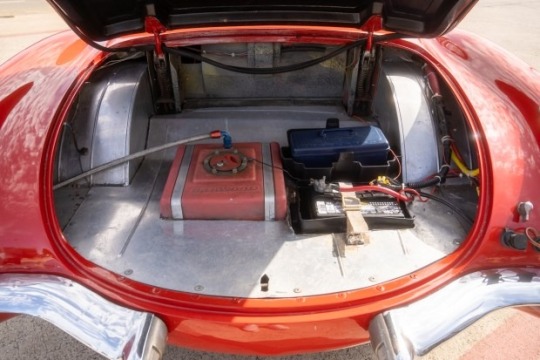
1958 Chevrolet Corvette
A Harwood plastic fuel cell is mounted in the trunk, which has been tubbed with fabricated aluminum panels to accommodate the rear wheels.
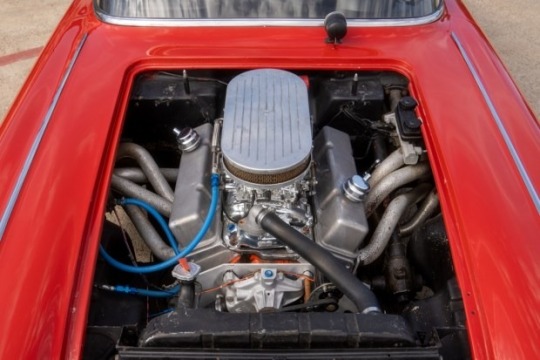
1958 Chevrolet Corvette
The 350ci V8 engine block, bored and stroked to 383ci, features four-bolt main bearings. The build includes forged pistons, ARP fasteners, a polished Edelbrock intake manifold, dual Edelbrock carburetors, an MSD ignition module, and Hooker long-tube headers that flow into side-exit exhaust pipes.
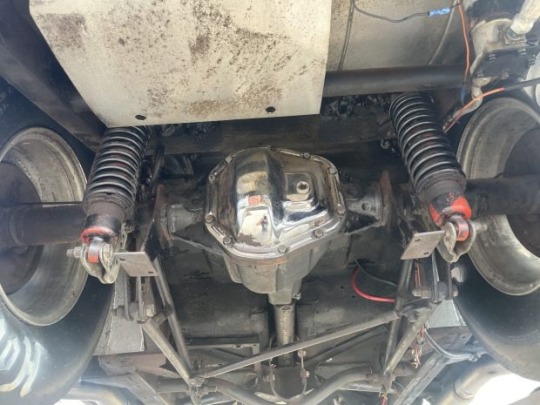
1958 Chevrolet Corvette
Power is transmitted to the rear wheels through a TH350 three-speed automatic transmission and a narrowed Dana 60 rear axle with a limited-slip differential.

1958 Chevrolet Corvette
155 notes
·
View notes
Text
Space Station Concepts: Space Operations Center


"The SOC is a self-contained orbital facility built up of several Shuttle-launched modules. With resupply, on-orbit refurbish- ment and orbit maintenance, it is capable of continuous operation for an indefinite period. In the nominal operational mode, the SOC is manned continuously, but unmanned operation is possible.
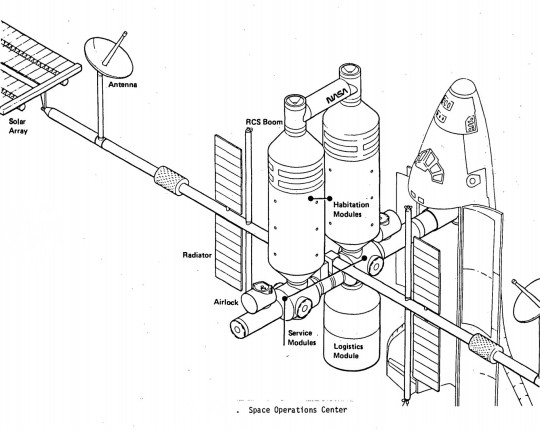
The present mission management and control process is characterized by a people-intensive ground monitoring and control operation involving large supporting ground information and control facilities and a highly- integrated ground-flight crew operation. In order to reduce dependence on Earth monitoring and control, the SOC would have to provide for increased systems monitoring; fault isolation and failure analysis, and the ability to store and call up extensive sets of data to support the onboard control of the vehicle; and the onboard capability for daily mission and other activity planning."

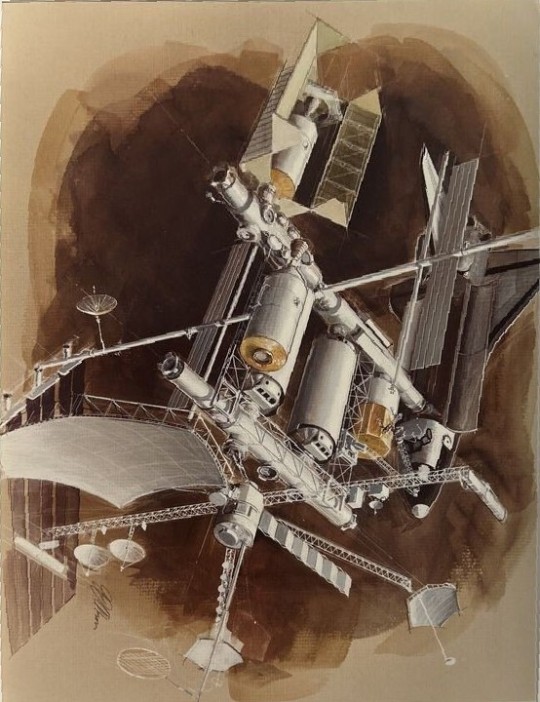
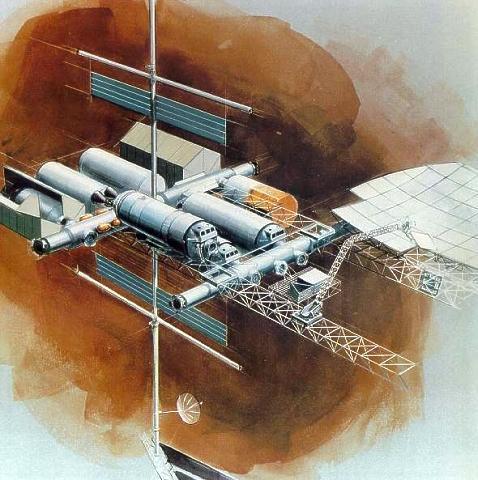
"Like most other space station studies from the mid/late 1970s its primary mission was the assembly and servicing of large spacecraft in Earth orbit -- not science. NASA/JSC signed a contract with Boeing in 1980 to further develop the design. Like most NASA space station plans, SOC would be assembled in orbit from modules launched on the Space Shuttle. The crew's tour of duty would have been 90 days. NASA originally estimated the total cost to be $2.7 billion, but the estimated cost had increased to $4.7 billion by 1981. SOC would have been operational by 1990.
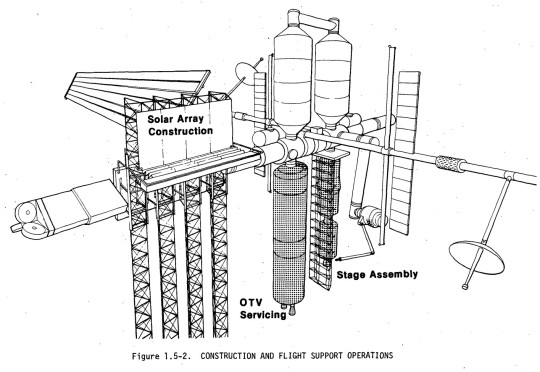


NASA's Johnson Spaceflight Center extended the Boeing contract in February 1982 to study a cheaper, modular, evolutionary approach to assembling the Space Operations Center. An initial power module would consist of solar arrays and radiators. The next launches would have delivered a space tug 'garage', two pressurized crew modules and a logistics module. The completed Space Operations Center also would have contained a satellite servicing and assembly facility and several laboratory modules. Even with this revised approach, however, the cost of the SOC program had grown to $9 billion. Another problem was Space Operations Center's primary mission: spacecraft assembly and servicing. The likely users (commercial satellite operators and telecommunications companies) were not really interested in the kind of large geostationary space platforms proposed by NASA. By 1983, the only enthusiastic users for NASA's space station plans were scientists working in the fields of microgravity research and life sciences. Their needs would dictate future space station design although NASA's 1984 station plans did incorporate a SOC-type spacecraft servicing facility as well."
Article by Marcus Lindroos, from astronautix.com: link

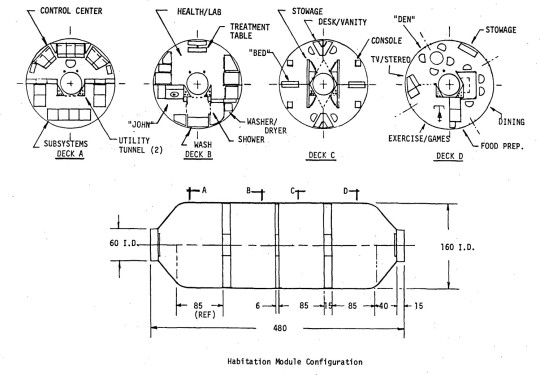


NASA ID: link, S79-10137
Boeing photo no. R-1859, link, link
#Space Operations Center#Space Station Freedom#Space Station Concept#Space Station#Concept Art#Space Station Program#Space#Earth#Space Shuttle#Orbiter#NASA#Space Shuttle Program#1979#1980s#my post
458 notes
·
View notes
Text
New oc for thee: SKUR "Großer Skua”

Under the cut are numerous doodles and SO MUCH YAP it’s very long so be warned.
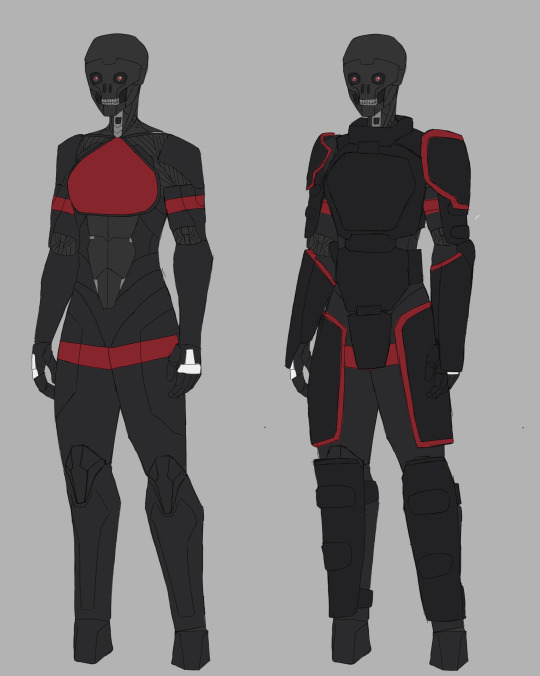



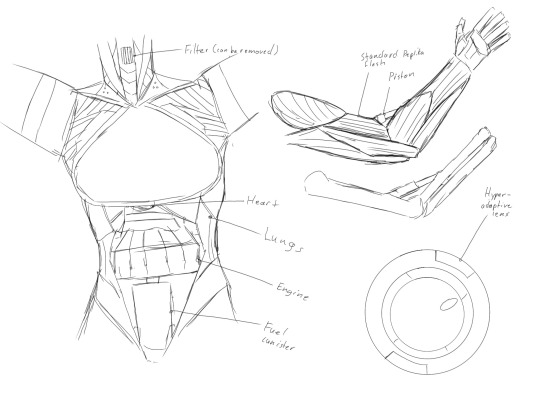

SKUR
Schwere-Kommando-Ungeheuer-Replika
Heavy-commando-Behemoth-Replica
Großer Skuas, or Schwere-Kampf-ungeheuer-Replikas, “Great Skuas”, often simply referred to as Skuas, are heavy commandos utilized by the nation in dangerous raids. These units are large and bulky, wearing heavy armor and welding weapons that are usually too heavy not to be on a mount. They operate in small groups, usually one to three, commanded by a KLBR, STAR, LSTR, STCR unit, or with an infantry force.
Skuas use a wide variety of heavy weapons, from machine guns and grenade launchers to flamethrowers and shotguns. Whatever the weapon, they’re always hyper-powered and usually too heavy for most units to even carry, much less use. They can unmount vehicle machine guns and use them in a man-portable fashion. Their armor is strong enough to block shotgun rounds at point blank range. Despite their large, heavy appearance, Skuas are deceptively fast. They carry cargos of ammunition and gear, and can be used as workhorses for transport.
Skuas are the perfect soldier in a way that an angel is the perfect human. They’ve been stripped from their humanity in a barbaric defiance of the natural order of creation, leaving an abomination whose sole purpose is bringing death in the most destructive manner possible. They feature skinless, fleshless, skull-like-heads, and many of their internal organs have been replaced with mechanics. They have no stomach and run instead on pressurized gasolines, and can create improvised fuels from processing and liquidizing organic matter, allowing them to attain fuel in the field and go without supplies for close to years. They can go without fuel for up to a week, and their fuel-processing systems allow them to live on diets of wood and even flesh. Their internal fuel systems and generators are located where their stomach and other organs used to be. Connected to the fuel system and remaining heart and lungs is a sophisticated engine that emits a low whir or hum. With no lips, their voicebox is located directly in the back of the throat, and sounds more mechanical than a normal replika. Their voice tends to be unsettling, like it’s not real or that it cuts through one’s ears. They will often cough the exhaust from their internal engine systems.
Skuas do not feel pain, and will instead feel a dull pressure when damaged, only so that they’re aware of their wounds. They must be watched closely as they see no difference between a pinprick and decapitation. They feature air filters in the neck and are immune to toxins, and can breathe even through even the thickest smoke and dust. Advanced cooling and ventilation control systems allow them to survive in both extremely hot or cold environments. Their joints are more mechanical, mixing machine pistons with their pseudo-flesh to strengthen them. Their cranial construction and nervous system are organic and interconnected with their machine structures and systems. They lack conventional eidetic modules and utilize instead camera-like lenses that are more immune to flash-grenades and cannot be blinded by debris. A built-in decibel limit also prevents becoming deaf, temporarily or otherwise. Arteries and veins are seamlessly integrated with the other mechanical systems. Though they possess no stomach, intestines, liver, kidneys, and other artificial internal organs that replikas typically have, they still have their heart, blood, and lungs to pump oxygen into the fuel systems.
Skuas operate well alone and in groups. One can be sent on a near-suicidal operation or can serve as support for a larger infantry.
Skuas are generally led by a handler, usually an Elster, Kolibri, Storch, or Starling unit. Each handler type fulfills a different role. Elster units lead Skuas far into unsurveyed enemy territory with little information and even less support. Storch-led Skuas operate raids. Starlings lead Skuas among other infantry, and Kolibris will operate a wider variety of roles in-high-stakes operations. Roles may vary, such as Elster units leading a defense campaign or a Starling leading a raid.
The commanding handler of Skua units must be evaluated for loyalty, as Skuas are easy to manipulate due to their unwavering, unquestioning, and extreme obedience. Commanding officers’ sole role is to manage the commandos, dealing with maintenance and orders. While not higher ranking than other officers, having the deadly and intimidating behemoths under their command affords handlers an uncanny authority. Skuas will develop close bonds with their commander, and are extremely protective of them.
Due to their skinless, faceless nature, Skuas are difficult at best to read. It is hard to gauge their emotions by their voice, which itself is monotone and formal, and their demeanor is similarly difficult to gauge. Their commanding handlers are expected to understand the subtle signs that signify their mental state, such as a clenched jaw in anger, and the activation of ventilation systems located in the neck and spine when flustered. Skuas do not possess tear nor mucus ducts, and will emit sporadic growls and hums instead of crying. Similarly, harder, louder, more aggressive growls can be heard if the Skua is particularly angry. When especially happy or content, they will produce deeper, louder humming sounds akin to purrs. Skuas also lack sweat glands, using their internal cooling and ventilation systems to stay at optimal temperature. Oddly, a byproduct of their unorthodox nerve system is that they enjoy being pet. Handlers discover a ‘sweet spot’, usually located on the torso.
Skua personalities appear dull and empty. They speak in monotone voices and tend to be very passive. In combat, they are aggressive and destructive, yet calm, causing maximum damage in minimal time. They fight in an oppressive fashion, fighting in such a manner that enemy combatants hardly have a chance to fire back. Unlike other combat units, they show no affinity nor fondness for violence, it’s simply a task that must be done. Skuas are wholly and entirely obedient to commanding units, utterly unquestioning of the even most appalling orders. While deep down, a sense of morality can theoretically be found, said ethics are completely ignored when an order contradicts what little there is. They will not go out of the way to cause maximum collateral, but have no qualms about it. For these reasons, Skaus can also function as executors. Their obedience makes them easy to manipulate, and are generally under the command of a replika instead of a gestalt. Upon further interaction, Skuas will reveal a calm and soft personality, akin to MNHR type units. When interacting with other units, they will minimize movement, as they do not know their own strength and can cause injury. They tend to not speak, aware of the intrinsic unsettling quality of their voice.
Skuas are physically terrifying to most units. Faceless, monstrous, destructive, and smelling of exhaust, they’re avoided almost entirely. They serve as omens to mass destruction to the enemy. Skuas themselves have no particular fondness for specific units. If any treats them as more than a demonic tool, they will attempt to befriend the person. Showing affection to the unloved units is an effective and easy way to gain their trust. Underneath their corpse-like and violent exterior, Skuas are gentle souls. They are fascinated by gestalts and their lives, as well as other replikas, and display a childlike curiosity with the world. They stabilize their persona by drawing and sketching. They may tattoo each other’s armor so that others can tell them apart, usually drawing little more than numbers. Often, one can find Skaus hidden just off the area where Eules work, as they listen to their singing and music. They enjoy looking for flowers when off duty, and will decorate each other with them.
Naming conventions are random. They have no preference for names and are generally named by their commanding officer, sometimes others, very rarely themselves. More personalized names stem from commanders. More generic names will come from nearby compatriots.
While technically female, Skuas are often referred to as “it” by others, not afforded the luxury of humanization. They make no movements to correct the notion. They are seen as unmanned combat vehicles rather than replikas, and they know it. Handlers are to refer to them more humanely, and are to provide names if a unit doesn’t have one.
The gestalt template for the Skua unit was a gunner in an aircraft crew, chosen for their keen eye, unyielding loyalty, and will of steel. Skuas are to be kept on-ground purely as foot soldiers to minimize resurfacing memories. Degraded Skuas are extremely dysphoric and must never look into a mirror. When degraded, Skuas remain mostly obedient but erratic and confused. They become unsteady on their feet and will attempt to board aircraft. Obedience will not decline, but they will question unfamiliar commanders. Late-stage degradation will reveals mania and violence. Decommission degrading Skuas immediately as soon as degradation is confirmed. They can easily be disposed of by having their handler disarm them, though convincing their handler to do so may be difficult. Use anti-armor rounds for a quick operation.
#If I’ve seemed less active it’s because I was working on this chucklefuck#Obsessing over her so mich#Almost 8 foot tall behemoth listening to tiny kopipi:#Fun dynamics and fun stuff planned#skua#skua signalis#Signalis oc#signalis fanart#my art#signalis
45 notes
·
View notes
Text

Many of the structures built on this planet, particularly ancient sacred sites, have information stored within stone. In the same way, you have information stored within the bones of your skeletal form. When you allow sound to move through you, it unlocks a doorway and allows information to flood into your body. It also penetrates the ground, affecting the vibrations of Earth and allowing a rearrangement of a molecular alignment of information to take place… Sound is a tool for transformation. Keepers of Frequency, which is what we are encouraging you to become, learn how to modulate the frequency they hold through sound. Sound can penetrate any substance, move molecules, and rearrange realities.
In ancient Egypt, the ankh, or symbol that represented life, in actuality was a frequency modulator. It was utilized by individuals who were masters of keeping frequencies and able to do many things with those frequencies. The ankh is similar to a tuning fork and can direct sound. That is how it was used a long time ago.
Before you will be able to experience using sound in the manner of the ancient Egyptians, you will have to demonstrate your integrity. You will have to pass an initiation or a testing to see whether you can be trusted with this kind of power. This planet is not ripe for this kind of energy simply to be thrust into anyone’s hands. If you were capable of this kind of work at this time, your life would not be safe because there would be too many who would want to misuse your gift.
You will be given abilities as you can best mature into them.
You can begin to work with sound by allowing it to “play” your body. Get yourself centered, clear your mind, and allow tones to come through you. The ancient mystery schools worked with sound in this manner, and it is a very powerful technique when done in a group. Many years down the road, but within this decade, you will amaze yourselves with what you will perceive as the results of your cooperative sounds or symphonies of consciousness playing themselves. When you tone together, you will be shown what you can do without even knowing you can do it.
You will learn how to use and cultivate this kind of energy to make your own ankh.
The creative form of sound is shown to you first as a potential. You are led and orchestrated through the use of this sound. Eventually, you will discover on your own some of the things that sound can achieve. Then you will become more daring, and you will learn what sound can create. Energies are introduced this way to make certain there is not a misuse of them and that you don’t overextend yourself or overdo out of enthusiasm.
You will go very far with your use of sound after working with it for awhile. It is like a powerful tool being given to an infant. Without proper awareness, you could do things and not realize the ramifications of what you are doing. Think about what sound does in stadiums and auditoriums. The cheering or booing of a crowd creates an ambience. When groups of you make sound together, you create an ambience for yourselves.
You allow certain energies to play the instrument of your bodies. You let go of preconceived ideas and allow different melodies and energies to use your physical bodies as opportunities to represent themselves on the planet. In actuality, what you experience is the life force of energies that you allow to express through your own selves. You become channels.
Just as our vehicle allows us to come into your reality through her body, you allow a vibration to come onto the planet in its full glory through your bodies and your joint cooperation. You birth something. You create an opportunity, and an energy takes advantage of that opportunity..
The Pleiadians - Barbara Marciniak
25 notes
·
View notes
Text
At great personal expense (3 Module Data Blocks) I got Kal'tsit's Integrated Strategies module for testing purposes.

I can safely say, if there was any doubt, that it makes an already powerful unit stronger, and is better than the other modules when applicable. Full stop. I could end this post here, but I like running my mouth and will now explain why.
Kal'tsit is an obviously powerful unit to any who use her, a semi-subpar medic that comes with a fast redeploy centurion. She can easily fulfill the roles of laneholder, bosskiller, blocker, tank, and interceptor, all on the same map with proficient usage. However, there are of course downsides, weakness, and limitations that help keep her in check: - The centurion, Mon3tr, can only be healed by her, and she will prioritize healing it and herself over anything else. When forgotten it's possible for this detail to lose a map, especially when she decides topping off herself is more important than Cuora dying to poison mist. - Secondly, Mon3tr occupies a second deployment slot, which can be a hindrance and on certain levels hard to justify over bringing an actual medic and an actual guard. - Lastly, as Kal'tsit cannot deal with enemies by herself, and Mon3tr cannot be deployed without Kal'tsit, it renders the combo a relatively expensive DP investment of 30.
These issues are often even more sore in Integrated Strategies; - If she is your only healer, it can prove disastrous to try and depend upon if she or Mon3tr take any damage, chip or heavy. - You can be extremely limited by deployment slots midway or late into a run, and a unit that requires two deployment slots to function can be a bad investment and rendered useless. - IS stages are prone to attacking quick and ramping up quicker, and trying to accrue 30 DP when enemies are already engaging is rough.
Despite that, due to Mon3tr's egregious stats and Kal'tsit's outrageous skills, she can pull ridiculous weight and is often a great pick in IS due to her insane role compression. She can fulfill nearly any role outside of anti-air. So if we look at her new capabilities via the new module in relation to these issues, the first two of her main drawbacks have been completely eliminated: - She heals a target on top of Mon3tr or herself, nullifying her weighted targeting (and making her heal way better when at full health). - There's no longer a deployment slot issue, giving Mon3tr even more incredible utility.
These alone, in my mind, would be enough to make the module the ideal pick in Integrated Strategies, as Kal'tsit's flaws that the gamemode exacerbates are completely patched. From the perspective of making her better suited for the gamemode (and ignoring how bizarre an IS-only-module is), it does a good job of making her feel better to use and addressing the issue of incidence.
Also, it's completely broken and objectively the best choice (it's not even close) because on top of that it also gives Mon3tr the stats of a 7* crusher that goes insane with any form of scaling: - +50% Max HP (5048 -> 7572) - +50% ATK (1317 -> 1975) - +50% Healing Received
33 notes
·
View notes
Text

Drone Boot Sequence
PDU-069 - Boot Sequence (Post Recharge Cycle)
Phase 1: Initial Power & Diagnostics
[00:00:01] POWER_RELAY_CONNECT: Main power bus energized. Energy cells online. Distribution network active.
[00:00:02] BATTERY_STAT: Energy cell charge: 99.9%. Cell health: Optimal. Discharge rate within parameters.
[00:00:03] ONBOARD_DIAG_INIT: Onboard diagnostics initiated.
[00:00:05] CPU_ONLINE: Primary processor online. Clock speed nominal.
[00:00:06] MEM_CHECK:
RAM: Integrity verified. Access speed nominal.
FLASH: Data integrity confirmed. Boot sector located.
[00:00:08] OS_LOAD: Loading operating system kernel...
[00:00:15] OS_INIT: Kernel initialized. Device drivers loading...
[00:00:20] SENSOR_ARRAY_TEST:
VISUAL: Camera modules online. Image resolution nominal.
LIDAR: Emitter/receiver functional. Point cloud generation nominal.
AUDIO: Microphones active. Ambient noise levels within parameters.
ATMOS: Temperature, pressure, humidity sensors online. Readings within expected range.
RADIATION: Gamma ray detector active. Background radiation levels normal.
[00:00:28] DIAGNOSTICS_REPORT: Preliminary system check complete. No critical errors detected.
Phase 2: Propulsion & Navigation
[00:00:30] PROPULSION_INIT: Activating propulsion system...
[00:00:32] MOTOR_TEST:
MOTOR_1: RPM within parameters. Response time nominal.
MOTOR_2: RPM within parameters. Response time nominal.
MOTOR_3: RPM within parameters. Response time nominal.
MOTOR_4: RPM within parameters. Response time nominal.
[00:00:38] FLIGHT_CTRL_ONLINE: Flight control system active. Stability algorithms engaged.
[00:00:40] GPS_INIT: Acquiring GPS signal...
[00:00:45] GPS_LOCK: GPS signal acquired. Positional accuracy: +/- 1 meter.
[00:00:47] IMU_CALIBRATION: Inertial Measurement Unit calibration complete. Orientation and acceleration data nominal.
Phase 3: Communication & Mission Parameters
[00:00:50] COMM_SYS_ONLINE: Communication systems activated.
[00:00:52] ANTENNA_DEPLOY: Deploying primary communication antenna... Deployment successful.
[00:00:54] SIGNAL_SCAN: Scanning for available networks...
[00:00:57] NETWORK_CONNECT: Connection established with [e.g., "Command Uplink" or "Local Mesh Network"]. Signal strength: Excellent.
[00:01:00] MISSION_DATA_SYNC: Synchronizing with mission database...
[00:01:05] PARAMETERS_LOAD: Latest mission parameters loaded and verified.
[00:01:08] SYSTEM_READY: All systems nominal.
Phase 4: Final Status & Awaiting Command
[00:01:10] PDU_069_STATUS: Fully operational. Awaiting command from Drone Controller @polo-drone-001 Are you ready to join us? Contact @brodygold @goldenherc9 @polo-drone-001
41 notes
·
View notes
Text


BOSS - CE-1 Chorus Ensemble
"... yeah, there’s a reason why they occupy so much Cabinet real estate. The company created the “first” of a variety of effects, and was certainly the first to offer many types in compact boxes. However, one such pedal is a stone-cold all-time classic despite never being offered in Boss’s trademark compact enclosure. That pedal is the CE-1 Chorus Ensemble.
Released one year after parent company Roland’s flagship Jazz Chorus amplifiers, Boss did what was once considered the unthinkable. Following the rapid and perhaps unexpected success of the aforementioned amp series, Roland wasted no time with ripping a circuit straight from them and putting them in a floor unit. In fact, this circuit ended up being the first pedal to bear the Boss name, and what a first it was.
Back when the CE-1 was conceptualized, the idea of mains-powered pedals was pretty commonplace. Mu-Tron effects used them, and so did MXR on some of its more ambitious models. Onboard and oftentimes custom-wound transformers ensured that voltages would be stepped down at precisely the right increments in order to preserve tonal integrity and headroom.
Of course, most pedals of the time also ran on nine-volt batteries, establishing a standard that continues today. But before these standards were established, the idea of grandiose effects thrived under the usage of mains power. Such a boundless canvas allowed companies like Boss to rip entire hunks of circuitry straight from larger silicon conglomerates and put them right at a player’s feet. These days, very few manufacturers offer such exacting circuitry, and the few that do charge exorbitant prices.
The CE-1 is one particularly exceptional example of this practice, because it expands on the original circuit, with the added bonus that you can play it through an actual tube amplifier. It also adds an extra functionality that the Jazz Chorus just couldn’t match. The Jazz Chorus gives players both Chorus and Vibrato modes, and to that end, serves up three knobs, of which Speed and Depth are two. The third knob is actually a rotary switch that chooses either mode. While the JC-120 offers a footswitch input to toggle the effect on and off, the CE-1 does one better and converts the rotary switch into a stompable button, meaning you don’t have to do the Angus Young duckwalk back to your amp mid-set to change modes. Nobody wants to do this.
Roland’s Jazz Chorus—and thusly the CE-1—couldn’t have come at a better time for end-users or commerce. Californian semiconductor company Reticon developed the first bucket-brigade device (BBD) and distributed them through the usual suspects, including Radio Shack under the store’s in-house Archer brand. The only problem—again for end-users and commerce—was that each one cost a crazy amount of 1970s dollars. Even at wholesale prices, Reticon’s SAD series of BBD chips made effects a bit on the expensive side.
Shortly after in Japan, Matsushita released the genesis of the Japanese BBD boom that ended up sinking Reticon and all pedals that relied on it. The first chip off the Matsushita line was the MN3002 and found its way into the CE-1 tout de suite. With the combination of the relatively inexpensive BBD and the full-strength brawn of the circuit itself, the CE-1 made a splash in the effects world and primed the pump for Boss’s compact series to take the effects world by storm.
The most unsung piece of the CE-1 puzzle is the onboard preamp that preps the signal for its impending modulation. While many effects and amplifiers (especially of this era) features “high” and “low” inputs, they usually correspond to a brute force approach that swaps out resistors in the signal path. However, the CE-1 preamp section starts with an op-amp preamp circuit that sweetens the signal, and switching over to high mode inserts a transistorized gain stage between the input and the op-amp section. This adds a velvety gloss to the signal before it ever sniffs the BBD chip, catapulting your tone into heights unreached by lesser devices.
It’s not often that almost 50 years later, no effect of a given type has surpassed the first one ever created, but such is the case with the CE-1. Its combination of unsurpassed tonal brilliance, component count and wacky power requirements has cemented its place in the effects hall of fame, leaving even the most modern refinements squarely in the rear-view mirror."
cred: catalinbread.com/blogs/kulas-cabinet/boss-ce-1-chorus-ensemble
48 notes
·
View notes